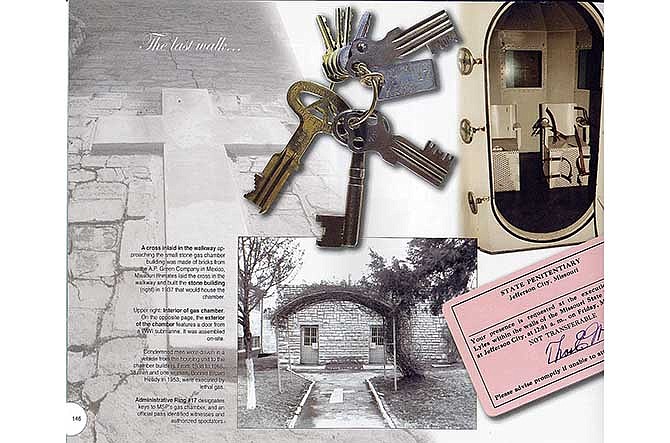The only witnesses to all 39 state executions at the Missouri State Penitentiary are missing.
Individually cut by the prison's locksmith in the 1930s, the keys to the gas chamber last were seen during a private tour in 2005.
Although distinctive in shape, the keys on a soldered ring are not labeled as the "gas chamber," but simply "admin keys 17."
The only known photo of the Folger Adam- and Stewart-styled keys is on page 146 of "Somewhere in Time," a book written by Mark Schreiber, MSP historian and former deputy warden.
Unlike most of the hundreds of keys used by prison staff inside the MSP, these keys likely were stored separately from the wall of keys for which officers would exchange their identification tags.
Only administrators were allowed access to the gas chamber keys while the prison was in operation.
The three most important keys on the gas chamber ring are to the front door and the two holding cells inside.
These keys would open the building to a
minimum of 25 witnesses and staff for each execution.
Only the keys bridged the gap between the 1965 lethal gas execution of Lloyd Anderson and the lethal injection of Tiny Mercer in 1989.
The prison closed in September 2004.
Before the Jefferson City Convention and Visitors Bureau received permission from the state's Office of Administration to organize tours, local historians hosted a few private tours.
A large group of more than 100 were divided into two groups on one particular day. The first tour guide left the keys in the door for the second guide.
Unchaperoned for just a few minutes in between, the keys disappeared.
Schreiber and another tour guide searched the gas chamber's roof and grounds and surrounding buildings without success.
A report was filed with the Capitol Police, not to press charges but, simply, to have the keys returned.
"Somebody has the keys somewhere," Schreiber said.
The seldom-used keys were for a very specific purpose. Based on information from a former prison locksmith, no back-up sets were made, Schreiber said.
More than an antique piece of history, the keys still are needed for a functional use.
As repairs and maintenance continue inside the prison, workers eventually had to cut through the locks to gain access to holding cells within the gas chamber, due to the fact the keys were missing, Schreiber said.
"Since they've been gone, we haven't been able to get in to the holding cells; we have watched the plaster fall," he said.
Without the return of the keys, the original locks may have to be replaced or welded so they no longer latch.
"Our hope is with public awareness we will get the keys back," he said. "The locking mechanisms are part of the structure's history."
The gas chamber has seen other changes throughout its history, such as the removal of ornate lamps and fencing. And a window was replaced with a second door in 1988.
The community continues to express support for the building's preservation, along with a handful of historically significant buildings on the site.
Maintenance and new roofing through the Office of Administration are ongoing. And several of the industrial buildings have been razed in the hopes of new development there.
Returning the missing keys would be a show of respect for the history that has occurred at the gas chamber and all of the MSP, Schreiber said.
"We have not forgotten they've been gone since 2005," he said.
The gas chamber is an example of the state's sociological history, Schreiber said.
"Use of the gas chamber is a chapter many choose to ignore, some are appalled and others support its justification," he said. "We're not dwelling on the capital punishment.
"The fact remains it was Missouri law."
As the Department of Corrections is an instrument in the judicial process, so the keys were the instruments used by the staff to carry it out.
"The keys saw justice tempered with tragedy," Schreiber said.


